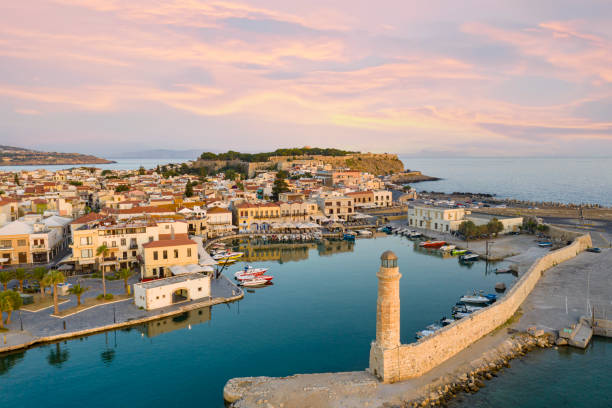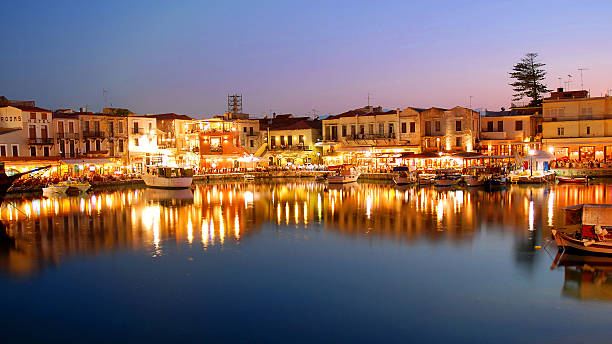City of Rethymnon
Rethymno is one of the four prefectures in Greece situated between the regions of Chania and Heraklion. It is washed by the Cretan Sea in the north and the Libyan Sea in the south. The central part of the capital of Rethymno is built on the cape and stretches along the beautiful long beach. A mountain range rises over the town, especially in the south, of which the highest peak is Mount Vrysina (858m).
The geography of Rethymno has vivid characteristics. The terrain of Rethymno Crete is mainly mountainous and with interesting characteristics that very much resemble the other regions of Crete. Dramatic gorges, plenty of caves, beautiful green valleys and small rivers, next to monuments that depict the long history of the region.
Venetian fortification works mingle harmonically with orthodox and catholic churches, mosques, majestic mansions of Venetian architecture, arches, and cobbled paths which create a magical atmosphere, reminiscence of the city’s turbulent –yet glorious– past.
Rethymno is the only city in Crete that is built on a cape, and more specifically, “on the boundary between calmness and fierceness,” as the location is eloquently described by local writer Pantelis Prevelakis.
There are two sides to Rethymno offering two styles of visit: the endless big beach hotel strip that stretches from the east end of Rethymno, lapping up the coastal "villages" of Perivolia, Platanias, Adelianos Kambos, Pigianos Kambos, Sfakaki, Stavromenos and Skaleta - and - the Rethymno that allows you the character of the old town with its mix of architecture and history, cultural influences and styles ranging from Venetian to Ottoman empire.
The Venetian Harbor, next to the modern harbor of the city, with the Egyptian lighthouse is one of the most picturesque areas of the Old Town of Rethymnon. It first operated in the Byzantine period (after 961), but flourished during the Venetian Times. The Venetians in the 14th century started major projects to face the problem of siltation, which holds till today. It is one of the most striking sceneries you can see in the town of Rethymnon and you can combine it with eating at one of the several seaside taverns.
The Fortress dominates the city and makes Rethymno very photogenic, its pedestrian streets below, strewn with charming old buildings. Venetian influences abound and the minarets and domed mosques remind of the Turkish influence long gone.
Numerous shops for souvenirs and many local products, trendy fashion or imaginative jewelry, the old and the modern combined to make a colorful and buzzing town.
Venturing outside the town, some days you will visit dramatic gorges, monasteries, time-trodden villages with ancient churches, the south coast Libyan sea, spectacular mountains of Psiloritis and the Lefka Ori (White Mountains).
During their 436-year rule, the Venetians turned Rethymno into one of the most important cities on the island and created its strong association with the Renaissance. They set up some splendid public buildings, churches and mansions, and they founded schools and literary societies, bringing a slice of European culture to Crete. Indeed, it is said that the Academy of the Vivi, established by Francesco Barozzi in 1562, was the first manifestation of organized cultural life on the island.
Later in 1646, Rethymno passed to the Ottomans. The churches became mosques, while Ottoman trelliswork, wooden bay windows, and covered balconies appeared above the elaborately carved entrances of the mansions. Contact with the rest of Europe was severed, but the general appearance of Rethymno did not change dramatically.
Strolling through the enchanting labyrinth of the Old Town you can see the Venetian legacy.
Some of the most representative products of Rethymno is the olive oil, cheese, herbs, spice mixes used in Cretan recipes, teas and wine. The local products are the epitome of healthy nutrition and anyone who visits this beautiful and picturesque town will discover that raki and wine are the best Rethymnian products.
Moreover, the city is famous for its great cheese varieties emphasizing on the mizithra, a low fat soft mashed cheese and anthotyro, a white soft cheese similar to the ricotta cheese.



